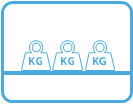
Enhanced Reliability-670W Vertex Module
Trina Solar released a series of testing results on the mechanical reliability of the 670W Vertex module. Covering six tests, including static mechanical load test and five rigorous tests including non-uniform snow-load test, extreme low-temperature mechanical Load test, hail test, extreme DML test and extreme wind tunnel test, the serial testing results achieved an across-the-board verification of the excellent mechanical load reliability of the 670W Vertex modules.

Static Load

Non-uniform Snow Load

Static Loading Under -40℃

Hail Impact

Enhanced Dynamic Load

Wind Tunnel Test
